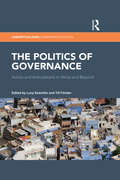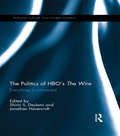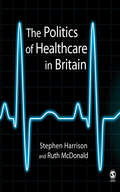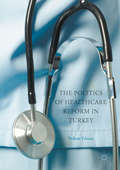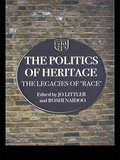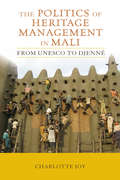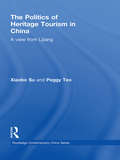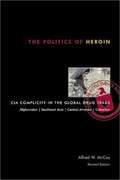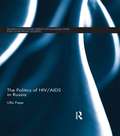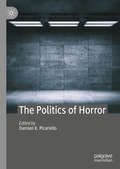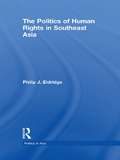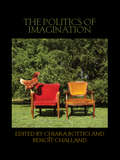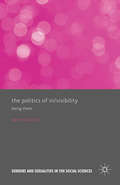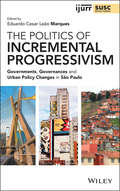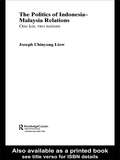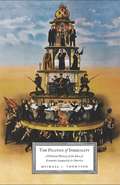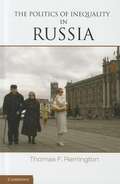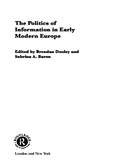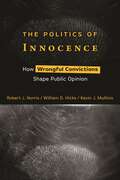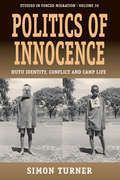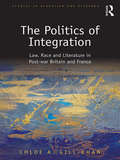- Table View
- List View
The Politics of Governance: Actors and Articulations in Africa and Beyond (Conceptualising Comparative Politics)
by Lucy Koechlin Till FörsterHow do government arrangements emerge? When and how does individual agency turn into collective agency? How do sensory experiences of violence, instability, etc affect the configuration of governance arrangements? When, why, and how are governance arrangements institutionalized? This book seeks to contribute to a non-normative conceptualization of the emergence and transformation of government arrangements, and addresses the under-theorization of actors and agency in conventional governance theories. The editors and contributors theorize the concept of governance more concretely by analyzing the key actors and arrangements that define states of governance across different places and by examining its performance and development in particular settings and time periods. Each contribution to the edited volume is based on a case-study drawn from Africa, though the book argues that the core issues identified remain the same across the world, though in different empirical contexts. The contributions also range across key disciplines, from anthropology to sociology to political science. This ground-breaking volume addresses governance arrangements, discusses how social actors form such arrangements, and concludes by synthesizing an actor-centered understanding of political articulation to a general theory of governance. Scholars across disciplines such as political science, development studies, African studies, and sociology will find the book insightful.
The Politics of HBO's The Wire: Everything is Connected (Popular Culture and World Politics)
by Jonathan Havercroft Shirin DeylamiThis innovative new work suggests that The Wire reflects, not simply a cultural take on contemporary America, but a structural critique of the conditions of late-modernity and global capitalism. As such, it is a visual text worth investigating and exploring for its nuanced examination of power, difference and inequality. Deylami & Havercroft bring together nine essays addressing issues of interest to a range of academic fields in order to engage with this important cultural intervention that has transfixed audiences and sparked debate within the social scientific community. While the TV show is primarily focused upon the urban politics of Baltimore, the contributors to this volume read Baltimore as a global city. That is, they argue that the relations between race, class, power, and violence that the series examines only make sense if we understand that inner city Baltimore is a node in a larger global network of violence and economic inequality. The book is divided into three interrelated sections focusing on systemic and cultural violence, the rise and decline of national and state formations, and the dysfunctional and destructive forces of global capitalism. Throughout the series the relation of the urban to the global is constantly being explored. This innovative new volume explains clearly how The Wire portrays this interaction, and what this representation can show social scientists interested in race, neo-liberal processes of globalization, criminality, gender, violence and surveillance.
The Politics of Health Care Reform: Lessons from the Past, Prospects for the Future
by Gary S. Belkin James A. MoroneThis distinguished collection stands out from the recent flurry of books on health reform by its sustained and sophisticated analysis of the political dimension. In The Politics of Health Care Reform, some of America's best-known political scientists, historians, and legal scholars make sense of our most turbulent policy issue. They dig below the jargon and minutiae to explore the enduring questions of American politics, government reform, and health care.The Politics of Health Care Reform explains how successful reforms occur in the United States and shows what is unique about health care issues. Theoretically informed, politically astute, historically nuanced, this volume takes an inventory of our health policy infrastructure. Here is an account of the institutions, ideas, and interests that shape health policy in the 1990s: Congress, the federal courts, interest groups, state governments, the public bureaucracy, business (large and small), the insurance industry, the medical profession. The volume offers a fresh look at such critical matters as public opinion, the politics of race and gender, and the lessons we can draw from other nations.The Politics of Health Care Reform is the definitive collection of political science essays about health care. Expanded from two special issues of the Journal of Health Politics, Policy and Law, the most prominent scholarly journal in the field it helped create, this collection will enliven the present debate over health reform and instruct everyone who is concerned about the future of American health care.Contributors. Lawrence Brown, Robert Evans, William Glaser, Colleen Grogan, Robert Hackey, Lawrence Jacobs, Nancy Jecker, Taeku Lee, Joan Lehman, David McBride, Ted Marmor, Cathie Jo Martin, James A. Morone, Mark Peterson, David Rochefort, Rand Rosenblatt, David Rothman, Joan Ruttenberg, Mark Schlesinger, Theda Skocpol, Michael Sparer, Deborah Stone, Kenneth Thorpe
The Politics of Health Promotion: In the European Union (Palgrave Studies in Science, Knowledge and Policy)
by Charlotte GodziewskiMuch has been written about policy efforts to achieve ‘Health in All Policies’: an ambitious attempt to improve population health and reduce health inequalities by ensuring multiple policy areas are more attuned to their health impacts. However, most accounts focus on technical challenges, such as implementing impact assessments. In contrast, and focusing on the European Union, this book argues that ‘Health in All Policies’ is essentially a political project shaped by institutional power, competing ideas, and discourses. We can only really understand the failure to realise its ambition through political analysis.
The Politics of Healthcare in Britain
by Stephen Harrison Ruth Mcdonald'This is an excellent textbook for which there is currently a niche in the market. The chapters on rationing, professionalism, politics of clinical knowledge and the politics of democracy and participation are particularly strong and will be invaluable to students of health policy, health studies and health service research' - Professor Michael Calnan, University of Bristol Written by leading academics in their field, this book provides a clear and considered overview of the politics of health care in Britain. Bringing together a wide range of material on both past events and recent developments, the chapters cover issues such as the politics of health professionalism, clinical knowledge and organisation and management. Each chapter offers a a unique combination of theory, historical detail and analysis of contemporary events. It features case studies to illustrate how policy has evolved and developed in recent years, and the implications these changes have for practice. Written in an accessible style the chapters also include comprehensive introductions, summaries and further reading sections. The final chapter is based on three detailed case studies that illuminate the tensions and debates discussed throughout the book. The Politics of Healthcare in Britain is a timely and authoritative textbook that covers a key topic of the curriculum whilst also contributing to topical debates. The book will be essential reading for students of social policy, health policy, public policy and nursing. It will also be of interest to policy makers and practitioners in the field of health care.
The Politics of Healthcare Reform in Turkey
by Volkan YilmazThis book explores the transformation in the healthcare system in Turkey since 2003, which has been portrayed as a benchmark for building universal healthcare systems in emerging market economies. Focussing on healthcare politics in an under-researched developing country context, it fills a significant lacuna in existing scholarship. This study answers these questions: What were the political dynamics that enabled the introduction of healthcare reform in Turkey? What political conflicts did the reform generate? How and to whose benefit have these conflicts been resolved? Drawing on qualitative interviews with a diverse set of actors, Yılmaz explores the actors’ subjective interpretations of the reform, the discourses and strategies they used to influence the reform, and the changing healthcare politics scene. He demonstrates that the reform has been a complex political process within which actors negotiated whether and to what extent healthcare remains a citizenship right or a commodity. This book will appeal to students and scholars of social policy, politics, health policy, public health and sociology.
The Politics of Heritage: The Legacies of Race (Comedia)
by Jo Littler Roshi NaidooWhile 'social inclusion' and 'cultural diversity' circulate frenetically as buzzwords, are we really ready to accept that ideas about 'race' and 'ethnicity', rather than being a peripheral concern, are at the core of how a nation's heritage is represented and imagined?This book interrogates just whose past gets to count as part of 'British heritage'. Bringing together a wide range of contributors, including academics, practitioners, policy makers and curators, it examines how many different of types of heritage - from football to stately homes, experience attractions to education - deal with the complex legacies of the idea of 'race'.Whether exploring the fallout of colonialism, the domination of 'England' over the other three nations, holocaust memorials, or the way British heritage is negotiated overseas, a recurring theme of this book is the need to accept that Britain has always been a place of shifting ethnicities, shaped by waves of migration, diaspora and globalization.Analyzing both theory and practice, this book is concerned with understanding the processes through which changes to heritage happens, and with exploring problems and possibilities for the future.
The Politics of Heritage Management in Mali: From UNESCO to Djenné (UCL Institute of Archaeology Critical Cultural Heritage Series #7)
by Charlotte L JoyThe UNESCO World Heritage Site of Djenné, in modern day Mali, is exalted as an enduring wonder of the ancient African world by archaeologists, anthropologists, state officials, architects and travel writers. In this revealing study, the author critically examines how the politics of heritage management, conservation, and authenticity play essential roles in the construction of Djenné’s past and its appropriation for contemporary purposes. Despite its great renown, the majority of local residents remain desperately poor. And while most are proud of their cultural heritage, they are often troubled by the limitations it places on their day to day living conditions. Joy argues for a more critical understanding of this paradox and urges us all to reconsider the moral and philosophical questions surrounding the ways in which we use the past in the present.
The Politics of Heritage Tourism in China: A View from Lijiang (Routledge Contemporary China Series)
by Xiaobo Su Peggy TeoThis volume unravels the politics surrounding behind China’s hegemonic project of heritage tourism development in Lijiang. It provides a compelling study of the dialectical relationships between global and domestic capital, the state, tourists and locals as they collude, collaborate and contest one another to ready Lijiang for tourist consumption. Using rich material from insightful interviews and quantitative data, the authors show how complex tourism development can be even as it strives to do good for the community. Su and Teo investigate the practices of contestation and negotiation of identity within Lijiang; analyze the negotiations that transform material and vernacular landscapes; and suggests strategies that will enable sustained tourism interest in this location. Linking Gramsci’s theory on hegemony to the cultural politics of space, this book has two major strengths: it establishes a theoretical framework to conceptualize power relations in tourism space and provides critical insights into the rapidly shifting socio-political landscape of contemporary China. Comparisons with other Chinese heritage sites are also provided. By addressing the power struggles inevitable in the process of tourism development, The Politics of Heritage Tourism in China provides an innovative understanding of China’s dynamic politics in a period of transition. As such, it will address the needs of students and academic scholars working in the fields of China studies, tourism, cultural studies, urban studies, sociology, geography, political science and heritage studies.
The Politics Of Heroin: CIA Complicity In The Global Drug Trade
by Alfred McCoyThe first book to prove CIA and U.S. government complicity in global drug trafficking, The Politics of Heroin includes meticulous documentation of dishonesty and dirty dealings at the highest levels from the Cold War until today. Maintaining a global perspective, this groundbreaking study details the mechanics of drug trafficking in Asia, Europe, the Middle East, and South and Central America. New chapters detail U.S. involvement in the narcotics trade in Afghanistan and Pakistan before and after the fall of the Taliban, and how U.S. drug policy in Central America and Colombia has increased the global supply of illicit drugs.
The Politics of HIV/AIDS in Russia (BASEES/Routledge Series on Russian and East European Studies)
by Ulla PapeThis book studies the role of civil society organisations in the fight against HIV/AIDS in Russia. It looks at how Russia’s HIV/AIDS epidemic has developed into a serious social, economic and political problem, and how according to the United Nations Programme on HIV/AIDS (UNAIDS), Russia is currently facing the biggest HIV/AIDS epidemic in all of Europe with an estimated number of 980,000 people living with HIV in 2009. The book investigates civil society organisations’ contribution to social change and civil society development in post-Soviet Russia, and thus situates a specific type of civil society actors into a broader socio-political context and questions their ability to represent civic interests, particularly in the field of social policy-making and health. This allows for a better understanding of the dynamics of state-society relations in present-day Russia, and gives insight into the ways HIV/AIDS NGOs in Russia have used transnational ties in order to exert influence on domestic policy-making in the field of HIV/AIDS.
The Politics of Horror
by Damien K. PicarielloThe Politics of Horror features contributions from scholars in a variety of fields—political science, English, communication studies, and others—that explore the connections between horror and politics. How might resources drawn from the study of politics inform our readings of, and conversations about, horror? In what ways might horror provide a useful lens through which to consider enduring questions in politics and political thought? And what insights might be drawn from horror as we consider contemporary political issues? In turning to horror, the contributors to this volume offer fresh provocations to inform a broad range of discussions of politics.
Politics of Human Rights in Southeast Asia (Politics in Asia)
by Philip J. EldridgeThe divide between the West and Southeast Asia seems to be nowhere more apparent than in debates about human rights. Within these diverse geographical, political and cultural climates, human rights seem to have become relative, and the quest for absolutes seems unattainable. In this new book Philip J Eldridge seeks to question this stalemate. He argues that the Association of Southeast Asian Nations' inclusion in United Nations' human rights treaties could be the common ground that bridges the gap between East and West. Eldridge uses topical case studies and primary research from Malaysia, Indonesia, East Timor and Australia, to compare the effectiveness of United Nations' human rights directives on local democracies. This study presents insightful research into a hotly debated topic. As such it will be a thought-provoking resource for students of human rights, politics and international relations.
Politics of Identity in Small Plural Societies
by Stacey-Ann WilsonIn small plural societies, cultural differences can be exaggerated, exploited and intensified during political contests. The survival of these societies as democracies - or even at all - hangs in the balance.
The Politics of Imagination (Birkbeck Law Press)
by Chiara Bottici Benoît ChallandThe Politics of Imagination offers a multidisciplinary perspective on the contemporary relationship between politics and the imagination. What role does our capacity to form images play in politics? And can we define politics as a struggle for people’s imagination? As a result of the increasingly central place of the media in our lives, the political role of imagination has undergone a massive quantitative and a qualitative change. As such, there has been a revival of interest in the concept of imagination, as the intimate connections between our capacity to form images and politics becomes more and more evident. Bringing together scholars from different disciplines and theoretical outlooks, The Politics of Imagination examines how the power of imagination reverberates in the various ambits of social and political life: in law, history, art, gender, economy, religion and the natural sciences. And it will be of considerable interest to those with contemporary interests in philosophy, political philosophy, political science, legal theory, gender studies, sociology, nationalism, identity studies, cultural studies, and media studies.
The Politics of Immigration in France, Britain, and the United States
by Martin A. SchainThis book argues that although labour market needs have been an important element in the development of immigration policy, they have been filtered through a political process, the politics of immigration. The book explores the relation between policy and politics in France, the UK, and the US.
The Politics of In/Visibility: Being There (Genders and Sexualities in the Social Sciences)
by Kath WoodwardVisibility matters in contemporary societies; online, in the media and in the public eye. But who is seen and how? Are women still seen through a male gaze? This book explores the politics of looking and being looked at, and the relationship between actual and virtual worlds, for example in sport, art and cinema.
The Politics of Incremental Progressivism: Governments, Governances and Urban Policy Changes in São Paulo (IJURR Studies in Urban and Social Change Book Series)
by Eduardo Cesar Leão MarquesThe Politics of Incremental Progressivism analyzes urban policies in São Paulo - one of the biggest and most complex Southern cities - not only challenging the misconception that large metropolises of the Global South are usually ungovernable, but showing the recent occurrence of progressive change. The first detailed and systematic account of the policies and politics that construct, maintain and operate a large Southern metropolis Analyzes the policies of bus and subway transportation, traffic control, waste collection, development licensing, public housing and large urban projects, additionally to budgeting, electoral results and government formation and dynamics Contains original researches about urban policies in a Southern metropolis, and a theoretical focus that bridges the gap between political science and urban studies Contributes to the understanding of how the city is governed, what kinds of policies its governments construct and deliver and, more importantly, under what conditions it produces redistributive change in the direction of policies that reduce its striking social and urban inequalities
The Politics of Indonesia-Malaysia Relations: One Kin, Two Nations (Routledge Contemporary Southeast Asia Series #Vol. 2)
by Joseph Chinyong LiowThis book provides a comprehensive overview of the relationship between Indonesia and Malaysia, focusing especially on how the relationship has developed in the last fifty years. It argues that the political relationship between the two countries has been largely defined by rivalry, despite the fact that the processes of national self-determination began by emphasising Indo-Malay fraternity. It shows how the two countries have different, contested interpretations of Indo-Malay history, and how the continuing suspicion of Javanese hegemony which defined much of the history of the Indo-Malay world is also a key factor in the relationship.
The Politics of Inequality: A Political History of the Idea of Economic Inequality in America
by Michael ThompsonSince the early days of the American republic, political thinkers have maintained that a grossly unequal division of property, wealth, and power would lead to the erosion of democratic life. Yet over the past thirty-five years, neoconservatives and neoliberals alike have redrawn the tenets of American liberalism. Nowhere is this more evident than in our current mainstream political discourse, in which the politics of economic inequality are rarely discussed.In this impassioned book, Michael J. Thompson reaches back into America's rich intellectual history to reclaim the politics of inequality from the distortion of recent American conservatism. He begins by tracing the development of the idea of economic inequality as it has been conceived by political thinkers throughout American history. Then he considers the change in ideas and values that have led to the acceptance and occasional legitimization of economic divisions. Thompson argues that American liberalism has made a profound departure from its original practice of egalitarian critique. It has all but abandoned its antihierarchical and antiaristocratic discourse. Only by resuscitating this tradition can democracy again become meaningful to Americans. The intellectuals who pioneered egalitarian thinking in America believed political and social relations should be free from all forms of domination, servitude, and dependency. They wished to expose the antidemocratic character of economic life under capitalism and hoped to prevent the kind of inequalities that compromise human dignity and freedom-the core principles of early American politics. In their wisdom is a much broader, more compelling view of democratic life and community than we have today, and with this book, Thompson eloquently and adamantly fights to recover this crucial strand of political thought. In this impassioned book, Michael J. Thompson reaches back into America's rich intellectual history to reclaim the politics of inequality from the distortion of recent American conservatism. He begins by tracing the development of the idea of economic inequality as it has been conceived by political thinkers throughout American history. Then he considers the change in ideas and values that have led to the acceptance and occasional legitimization of economic divisions. Thompson argues that American liberalism has made a profound departure from its original practice of egalitarian critique; it has all but abandoned its antihierarchical and antiaristocratic discourse. Only by resuscitating this tradition can democracy again become meaningful to Americans. The intellectuals who pioneered egalitarian thinking in America believed political and social relations should be free from all forms of domination, servitude, and dependency. They wished to expose the antidemocratic character of economic life under capitalism and hoped to prevent the kind of inequalities that compromise human dignity and freedom—the core principles of early American politics. In their wisdom is a much broader, more compelling view of democratic life and community than we have today, and with this book, Thompson eloquently and adamantly fights to recover this crucial strand of political thought.
The Politics of Inequality in Russia
by Thomas F. RemingtonThis book investigates the relationship between the character of political regimes in Russia's subnational regions and the structure of earnings and income. Based on extensive data from Russian official sources and surveys conducted by the World Bank, the book shows that income inequality is higher in more pluralistic regions. It argues that the relationship between firms and government differs between more democratic and more authoritarian regional regimes. In more democratic regions, business firms and government have more cooperative relations, restraining the power of government over business and encouraging business to invest more, pay more and report more of their wages. Average wages are higher in more democratic regions and poverty is lower, but wage and income inequality are also higher. The book argues that the rising inequality in postcommunist Russia reflects the inability of a weak state to carry out a redistributive social policy.
The Politics of Information in Early Modern Europe (Routledge Studies in Cultural History #1)
by Brendan Dooley Sabrina A. BaronIn its various European contexts, the invention and spread of newspapers in the seventeenth century had a profound effect on early modern culture and politics. While recent research has explored the role of the newspaper in transforming information into ideology in various European countries, this book is the first to bring this work together into a comprehensive and comparative survey.
The Politics of Innocence: How Wrongful Convictions Shape Public Opinion
by Robert J. Norris William D. Hicks Kevin J. Mullinix2024 Outstanding Academic Title, given by Choice ReviewsThe political dynamics that shape the Innocence MovementSince 1989, more than 3000 people are known to have been exonerated after being wrongly convicted in the United States. Each one of these cases represents a gross miscarriage of justice; they are stories of lives upended by a criminal legal system gone awry. Yet, this number just scratches the surface and does not capture the full breadth of wrongful convictions, which may well number in the tens of thousands.The Politics of Innocence explores the political dynamics that have shaped the proliferation of innocence-related policies across the United States and the ways in which wrongful convictions affect public opinion about the criminal legal system. Although some have suggested that this issue transcends ideological divisions, the authors argue that public opinion and the policies that address wrongful convictions are a product of the political landscape. Using original data, the authors show how political ideology influences awareness of the issue, affects support for policy reform, and, in particular electoral contexts, influences state policy adoption. The Politics of Innocence is a moving and data-driven account of wrongful convictions.
Politics Of Innocence: Hutu Identity, Conflict and Camp Life (Forced Migration #30)
by Simon TurnerBased on thorough ethnographic fieldwork in a refugee camp in Tanzania this book provides a rich account of the benevolent "disciplining mechanisms" of humanitarian agencies, led by the UNHCR, and of the situated, dynamic, indeterminate, and fluid nature of identity (re)construction in the camp. While the refugees are expected to behave as innocent, helpless victims, the question of victimhood among Burundian Hutu is increasingly challenged, following the 1993 massacres in Burundi and the Rwandan genocide. The book explores how different groups within the camp apply different strategies to cope with these issues and how the question of innocence and victimhood is itself imbued with ambiguity, as young men struggle to recuperate their masculinity and their political subjectivity.
The Politics of Integration: Law, Race and Literature in Post-War Britain and France (Studies in Migration and Diaspora)
by Chloe A. Gill-KhanAfter almost seven decades, Britain and France, nations with divergent political cultures and heirs to contrasting philosophies of 'integration', have proclaimed the failure to integrate their post-war ethnic minorities: at this present time, the ‘Muslim’. The ‘argument’ of this book, therefore, is a question: despite the legal, political and social commitments that emerged from the events of the Holocaust, why do both nations continue to govern minorities on the sites of the law and race? Through comparative readings of British Asian and Franco-Maghrebian literatures, the author examines the contours and patterns of British and French post-war governance and racism over four decades. Departing from prevailing theories in postcolonial studies that situate post-war racism within the narrative of colonialism or the politics of the nation-state, The Politics of Integration shows how we must re-appraise the inter-war histories of minorities if we are to ask more meaningful questions about the present. We are invited to take stock of how well theorization of post-war ethnic populations and their politics have served us in terms of asking: what does history tell us, and how and where do we - Europe and its minorities - go from here? As such, the book will appeal to scholars in multiple disciplines in the humanities and social sciences such as history, philosophy, literature, cultural and postcolonial studies.
